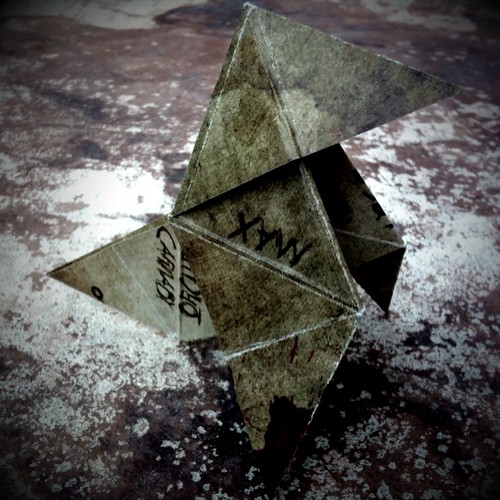
Kudos to Quantic Dream, what a clever way to occupy the player during the install process.

Kudos to Quantic Dream, what a clever way to occupy the player during the install process.
HoN Stats, a little Heroes of Newerth stat tracking app that a friend and I having been tinkering with on the side, is now live.
Or less succinctly, the iphone games that continue to maintain a prominent position in screens four and five (where games go, between day-to-day and apps in development) at the start of 2010, even though I’ve got other games that I really should be playing and/or researching instead.
Cobra Command ($4.99)

The iPhone has seen the rerelease of several classics from the laserdisc arcade era, including the Dyer and Bluth collaborations Space Ace and Dragon’s Lair, and while the mentioned games are both worth reliving, Cobra Command, a laserdisc title I played only once as a kid, is the only one I keep coming back to regularly.
Licensed and released for the iPhone by Revolutionary Concepts, Cobra Command somewhat straddles a laserdisc genre that had split into two camps: fully animated narratives stitched together scene by scene (with progression more or less based on a series of quicktime events), and more traditional arcade shooters with animated scenery and backgrounds (think Astron Belt or M.A.C.H. 3). The result is a visually interesting game requiring more skill and less rote memorization (although plenty of that is needed to), leading to its longer lifespan on my iPhone.
Zen Bound (currently on sale for $1.99)
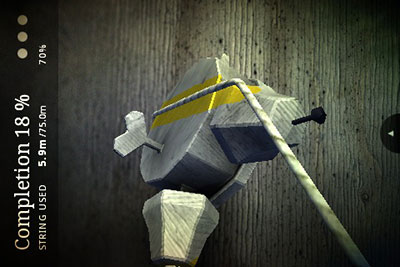
One of my first iPhone game purchases, and still one of my all-time favorites, Zen Bound plays to the strengths of the device, making clever use of tilt without the control scheme feeling gimmicky or tacked on at the insistence of a marketer’s bullet point.
As a bonus, the full soundtrack, written by downtempo artist Ghost Monkey, is freely available to purchasers of the app (click on Secret Exit in the main menu and enter your email address for a download link).
Hell, even the UI is fantastic.
Canabalt ($2.99)

The opposite of Zen Bound, Semi Secret’s Canabalt is frantic, maddening, and addictive, with distilled one-button gameplay and music by indie darling (and all-around good guy) Danny Baranowsky.
Version 1.2, now available, adds a new music track, new obstacles, and leaderboards (with a current and ungodly world high score of 367,562 meters).
Hot tip: tapping with my index finger instead of my thumb increased my top score by over 10,000. I’m told it has something to do with reaction timing, and why the same finger is used to time laps on a stopwatch.
Hi, How Are You (currently on sale for $.99)

Based on the work of artist and musician Daniel Johnston, Hi, How Are You is a solidly constructed surreal platformer with Q*bert mechanics.
The crew at Dr. Fun Fun has done an excellent job translating Daniel’s output into playable form, and the result is a smile inducing experience. While I’m not a fan of the default tilt control scheme, the alternative virtual d-pad feels and controls just fine.
Oh, and if you haven’t seen the 2006 documentary The Devil and Daniel Johnston, rent that first, then play the game.
Space Invaders Infinity Gene ($4.99)

Props to Taito for really knocking it out of the park with this one. Space Invaders oozes style, and is by far my favorite of all the classic gaming rehashes now available on the iPhone.
My only disappointment is that the extra use-your-own-music mode spits out levels based on metadata, rather than giving us the music-matching procedurally generated levels of games like Audiosurf and Vib-Ribbon. Still, awesome game.
PAC-MAN Championship Edition ($2.99)

Ported from the 2007 Xbox Live release designed by original game creator Toru Iwatani, PAC-MAN Championship Edition adds time and skill challenges, wrapping the PAC-MAN concept in a new veneer of slick presentation and sound. While virtual d-pads can be rough on a twitch-based game like this, Namco offers four variations, allowing the player to decide which is most comfortable (I prefer Type 2, seen above).
One of four different Namco iPhone games based on the PAC-MAN license, this is the one you’ll want to go with.
As the system that straddled the electromechanical and solid state eras, Gottlieb System 1 pinball machines were, even brand new, notorious for their electronic issues, and now that the components have aged for thirty years, the potential problems have only compounded. There are very few who’d call troubleshooting a System 1 an enjoyable experience, and some techs refuse to work on the machines entirely.
By the time I called Nick at Planet 9 Pinball, I’d rebuilt the power supply, replaced a half dozen of the transistors on the driver board, and had gotten everything up and running but the outhole kicker and a couple other troublesome bits. Unfortunately, I managed to short out the transistor on the bottom of the power supply against its bracket, setting off a minor chain reaction. This is when I called Nick.
He quickly resolved the remaining under-the-playfield issues and was able to get the machine back up and running, but while a testing low voltage issue he inadvertently discovered a bad potentiometer, shorting a handful of chips on the MPU board in the process. I replaced the bad pots, and over the course of the next week he tested and replaced MPU chips one by one until things were (mostly) back to working condition. Plans were made to source the remaining chips (for the display controllers), and Nick went on his way, vowing to never work on another System 1 game again.
[Btw, I highly recommend Planet 9, Nick’s a good guy, his rates are reasonable, and he’ll slog through the muck to get your machine up and running again.]
Knowing that the playfield mechanics were solid and that this machine would be living with me for years to come, I began to look into some of the more recent System 1 replacement boards developed by boutique outfits and hobbyists in the scene. I’d heard glowing reviews of a modern all-in-one board designed by Pascal Janin, and having just buffered my arcade project coffer with a few parts sales, I took the plunge and ordered his PI-1 X4.
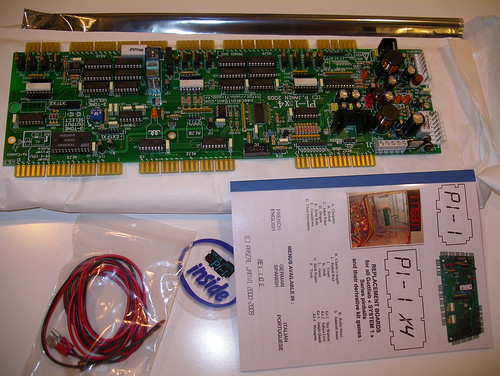
The PI-1 X4 fits into the backbox and replaces the power supply, MPU board, driver board, as well as the three-tone sound board mounted in the front of the cabinet. In addition to replicating the base game functions completely, it adds a whole mess of new features (skill shot, attract mode, free play, multiple high scores with name entry, etc), moves the stored data from battery backup to NVRAM, and corrects many of the faults of the original hardware.
Pascal’s manual was well thought out and installation took maybe 20 minutes. After thoroughly testing everything and setting the parameters via his display menu system, I gave the playfield a quick wipedown, replaced the glass, and played my first game on the fully working machine. Man, did that feel good.
Here’s the PI-1 X4 mounted in the backbox… lots of room leftover!

And finally, after too many hours, a lot of sweat, and a little bit of blood, here’s my finished Count-Down:
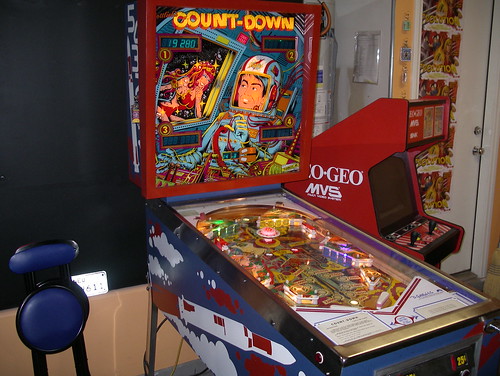
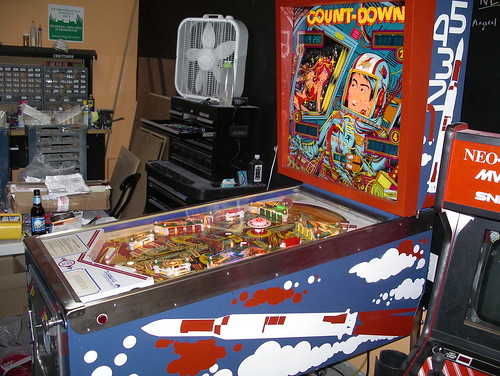
Count-Down in the dark! All new playfield lights, including colored LEDs in the inserts and behind the drop target banks:
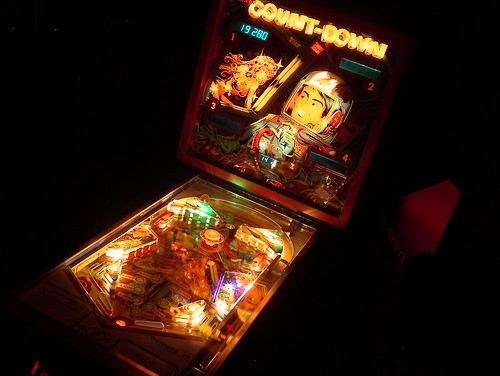
And a final gratuitous playfield closeup:
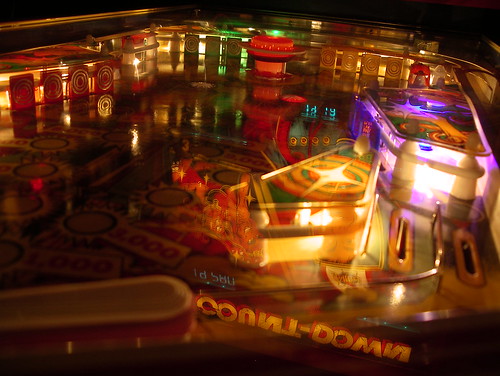
Retro extravaganza!
Download all 21 issues of DC Comics’ Atari Force, one of the more ah, interesting Atari licensing deals of the 1980s. The original pack-in issues (telling a previous story) are also available.
Scott Evans, curator of AtariGames.com, recently uploaded the CAX 2009 Atari alumni discussion panel. Available in 5 parts, Arcade Heroes has bundled them all into a single post.
The birth of an industry: Ralph Baer and His All-Purpose Boxes.
For the ZX Brits: 25 Years of Crash.